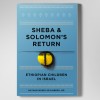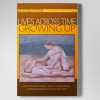Aliyah 3-15-06: Galilee
We — a bus troop of Hebrew-learners — hit the road to the upper and lower Galilee, in opposite order. A week ago Wed, off with the Ulpan, rising at 530 to get to Ulpan bus by 7 am. There is a quality of herding cats in such groups, with people meandering off and occasionally back. One girl from Switzerland insists that we stop the bus mid road, as her friend has just arrived at the Ulpan, which we left some ten minutes earlier: she’s only three minutes away, she insists. And we stop. Then, Miss Swiss exits the bus, one leg on, one leg off, assuring that we cannot leave; we learn that her friend is still on the highway, being driven by someone, who doesn’t’ know Netanya, so can’t find us. About ten minutes later, some reason prevails, and Opher — our Yemenite guide-song leader-accordianist-pianist-overall core of patience — negotiates Swissy back on the bus, with assurances that it is easier for her friend’s driver to find us downtown Netanya (where another group has been patiently waiting for our now-late arrival). This was a bit like reverse-hostage negotiation: Opher trying to convince Miss Swiss on-board so that we can be held in thrall en route, rather than mis-en-scene. When Swissy’s friend boards, both of them have a mad-on for our not waiting mid-road, rather than going into town. They’re steamed for a few hours.
Something curative of the above upon entering “god’s vineyard” — Carmel. We put Zikhron Yaakov on our right and Haifa north and behind us as we descend into god-will-sow valley, the Jezreel. “To sow,” the word in Hebrew, shares a root with the word, “arm,” connecting us bodily with the limb used to broadcast seeds, signs of hope, of future. This is a very “bodied” land, Israel, also one with sudden, even stark shifts of weather, and we are edging into the season of hope, of spring. Our guide, Sara, points out that this is the best time to see the flowers in the Galilee, before the summer heat wilts them. Life buds, even blossoms here, sometimes in hidden corners, such as the forests we will visit, in spite of the acrimony surrounding. Freud, after receiving Stefan Zweig’s enthusiastic book about Israel, thanked him, and remarked eliptically, that this is a strange land, from which little art or science has emerged, but only three illusions. (And of such illusions, Freud saw little future.) Freud finishes, it should be studied more.
So, let us study. We are on a geological and geographic trip today, getting the feel of this upper and lower Galilee. There may be several origins for the word “gallil,” wave, but the one I seem best to absorb is that the word captures the rolling waves of hills and valleys. At one point, “galllil’ itself was the word for “territory.” Flavius Josephus, that
remarkable turncoat who once was a Jewish general in this area, until caught by the Romans and saved his life by joining their forces. He revealed Jewish hide outs and such, writing a brilliant account of the Roman slaughter and conquest of the Jews, including the last days of Masada. To him we should have some gratitude. Perhaps. He writes
extensively about the geography of this turf, a major route connecting Egypt and Damascus. His twenty-century-old book passage can serve as a tour guide.
Or, we can turn to our faces. Trace from your neck upwards, and you have the gallil. Start from your big toe (standing en pointe, one jambe resting on the other’s thigh), one arm eleve, finger pointing upwards, and you have the whole of Israel. Start with your belly button, to find Jerusalem. The toe is Eilat. (Beersheva is that depression in between found on females.) The mounds of two mountain ranges north of Jerusalem are better found on women. The neck is god’s sowing valley, the Jezreel. Then to the face: the Jordan river defining our left ear, the Mediterranean our right. The chin is the range extending east from Mt. Carmel, then a valley, followed by lower lip Tuan, the parsing of lips of Netufa Valley, the upper lip of Yotfat, a valley leading to the nose of Mt. Meiron, with Tzfat sitting astride our left
nares. When I look at the map and compare with my body map, it looks a bit lopsided, leaning a bit to the left. But there is a lopsided quality to this land.
While we are to feel the geography, the history is too tempting for Sara and us as we run through along the neck of Jezreel. With Carmel to the left, she recalls the story of Elijah and the 450 prophets of Ba’al, which begins on the mountainside, and ends in a bloody path to the Kishon River. (“River” is a relative term in this land of dry.) I do not know my prophets well enough and she obliges. After three years of no rain, none, the prophets of Ba’al challenge Elijah to a god-duel atop the mountain. They announce that they will pray mightily, then a flash of fire will descend to their altar and rain will follow. They play Ba’al, step up to the plate and whiff out. Elijah, feeling his oats, apparently, suggests that they pray a bit more, another turn at bat. They oblige. They are pitched to three strikes again. Then Elijah steps to the plate, lofts his ash wood, glints at the mound and gives a wink. (I added the wink.) First nada, nichts, rien. Then, a small cloud appears in the West, from the Mediterranean. A cloud the size of a palm. Then a flash of fire and drenching rain. Grand slam! The Ba’al players proclaim their belief in Elohim, changing sides mid-game, and begin running to home plate, which is down hill and towards the Kishon. The spectators of the Jewish team, have nothing to do with this change of heart, and wipe out the Ba’al team en route. None make it home. Game called because of rain.
The drive across the bridge of the Kishon is a hiccup. Hiccup and you can miss it. But somewhere around here occurred also the story of Deborah, the judge and Barak (lightening) her general. Told to take on Sisra and his attacking marauders, who “visited” periodically, generally around harvest to rob, pillage, kill (the usual suspects), Barak responds to Deborah, “O.K., but only if you are there.” She says, “Cool, but then everyone will think it is a victory of a woman.” He takes this in stride, it seems. Deborah figures that after the rains the night before, Sisra’s charioteers will be more vulnerable in the muddy plains. She is right; they get stuck; Barak comes in for the kills and Sisra escapes. He finds refuge in Yael’s tent and is thirsty. She serves him milk and he nods off. She drives aspike through his temple. Tough chicks seemed bred around here.
I’ll breeze through the rest for now. We keep ascending. We crest above the Netufa valley and see the huge water transportation system that Ben Gurion insisted would be built to irrigate the Negev. Coming from the Kinneret, it runs above ground, empties into some artificial lakes in the Jezreel valley, where the water is freshened, then heads below ground to somewhere around Petach Tikva, then to the desert. We stand on a crest looking on the patchwork of deeply green-hued small farm plots in the Netuafa valley. If I recall correctly, these Arab farms were once Moslem and Christian. A few years back, the Moslems slaughtered the Christians. There you have it. The farms are divided among brothers as fathers die, so the plots get smaller. Looks beautiful from a distance. The water channels from the Kinneret decorates one side of the valley, like a string of sapphires.
By afternoon, we are ascending the Meiron. We are to visit the graves of some millenia-old pre-rabbis, an adoptive father who raised his orphan son. I don’t recall names, but they often disagreed about religious interpretation, but they lie eternally together. Somewhere near here, the gemarrah was signed. We have been a mobile nation, carrying our stories, our laws, and our debates with us. Light travelers, with heavy matters.
We descend a mountain side and Sara helps us discover the flowers, tiny, as is this country. There are two species of oaks here, but “oak” does not capture the modest size of most of these trees. They are a few steps up from bonsai and nothing like in the US. Much deforestation was done by the Turks during W.W.I to get rails for their army. One area is spared, which was populated by Germans (not Jews), who did careful harvesting to satisfy the Turks, but retain the forest.
Tulips. The Crusaders brought the tulip from Israel to Europe, so I am told by Sara. I hadn’t realized how much the Dutch were indebted to Israel. But the tulips here are also diminutive, relatively speaking. Slipper orchids. Kaloniot — the flower of red petals and a collar of white, made into a lovely, yearning song by Shoshana Damari, who died recently.
We visit Biriya, a site of resistance against the British; the only settlement to be completely evacuated by the British. Then the surrounding Jews ascended to protest the removal. This was a colony of religious Zionists. We look at photos with the guide, who names young men and woman, many in their teens, who later continue to contribute to the State. Some are still living.
I will return to this again, this trip over rolling waves of the Gallil.



